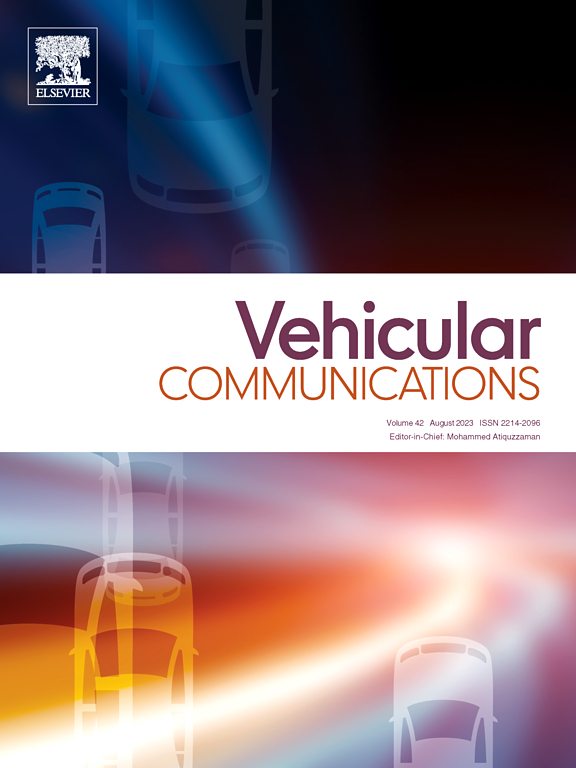A distributed multi-agent joint optimization algorithm based on CERL and A2C for resource allocation in vehicular networks
IF 6.5
2区 计算机科学
Q1 TELECOMMUNICATIONS
引用次数: 0
Abstract
Vehicular networking plays an indispensable role in enhancing road safety and traffic efficiency. Although existing technologies have made significant progress in reusing vehicle-to-infrastructure (V2I) link resources for vehicle-to-vehicle (V2V) links, they still face challenges such as the high dimensionality of the joint action space and unsatisfactory optimization with limited in-vehicle radio resources, variable environments, and uncertainties. Reinforcement learning-based joint algorithms that separately optimize channel allocation and power selection can reduce the dimensionality of the joint action space. However, it is difficult to effectively coordinate channel allocation and power selection, which greatly affects the performance of them. To address these challenges, this paper proposes a distributed multi-agent joint optimization algorithm based on a novel cross-entropy loss-based reinforcement learning (CERL) algorithm and the A2C algorithm for separately optimizing channels and power in vehicular networks. Furthermore, a multi-round stochastic search strategy is presented to optimize the experience pools and coordinate the channel allocation and the power selection for the proposed distributed multi-agent joint optimization algorithm. With the help of the multi-round stochastic search strategy, the proposed distributed multi-agent joint optimization algorithm can significantly improve the optimization performance in resource allocation. To evaluate the performance of the proposed distributed multi-agent joint optimization algorithm in both the V2V link transmission success rate and the V2I link throughput, a comprehensive simulation study is conducted under different channel resource availability scenarios with different sizes of security data. The experimental results demonstrate that our proposed algorithm can significantly improve the V2I link throughput and the V2V link transmission success rate, and outperforms the existing algorithms in terms of radio efficiency. Specifically, under two different channel resource availability scenarios, our proposed algorithm can achieve more than 99.9 % average V2V link transmission success rate and 2.99 Mbps and 2.07 Mbps higher average V2I link throughput than the competitive algorithm D3QN-LS when the security data size ranges from 1 × 1060 Bytes to 8 × 1060 Bytes. The proposed algorithm theoretically provides a new perspective and solution for separately optimizing channels and power in high-dimensional complex dynamic environments of vehicular networks.
基于CERL和A2C的汽车网络资源分配多智能体联合优化算法
车联网在提高道路安全和交通效率方面发挥着不可或缺的作用。尽管现有技术在车对基础设施(V2I)链路资源用于车对车(V2V)链路的重用方面取得了重大进展,但它们仍然面临着诸如联合行动空间的高维性以及车内无线电资源有限、环境多变和不确定性的优化不理想等挑战。基于强化学习的联合算法分别优化信道分配和功率选择,降低了联合行动空间的维数。然而,信道分配和功率选择难以有效协调,极大地影响了信道分配和功率选择的性能。为了解决这些问题,本文提出了一种基于交叉熵损失强化学习(CERL)算法和A2C算法的分布式多智能体联合优化算法,分别对车载网络中的通道和功率进行优化。在此基础上,提出了一种多轮随机搜索策略来优化经验池,并对所提出的分布式多智能体联合优化算法的信道分配和功率选择进行协调。利用多轮随机搜索策略,提出的分布式多智能体联合优化算法可以显著提高资源分配的优化性能。为了评估所提出的分布式多智能体联合优化算法在V2V链路传输成功率和V2I链路吞吐量方面的性能,在不同信道资源可用性、不同安全数据大小的场景下进行了全面的仿真研究。实验结果表明,该算法能够显著提高V2I链路吞吐量和V2V链路传输成功率,并在无线电效率方面优于现有算法。具体而言,在两种不同信道资源可用性场景下,当安全数据大小在1 × 1060 ~ 8 × 1060字节范围内时,本文算法的平均V2V链路传输成功率均超过99.9%,平均V2I链路吞吐量比竞争算法D3QN-LS高2.99 Mbps和2.07 Mbps。该算法从理论上为高维复杂动态环境下的车辆网络通道和功率分别优化提供了新的视角和解决方案。
本文章由计算机程序翻译,如有差异,请以英文原文为准。
求助全文
约1分钟内获得全文
求助全文
来源期刊

Vehicular Communications
Engineering-Electrical and Electronic Engineering
CiteScore
12.70
自引率
10.40%
发文量
88
审稿时长
62 days
期刊介绍:
Vehicular communications is a growing area of communications between vehicles and including roadside communication infrastructure. Advances in wireless communications are making possible sharing of information through real time communications between vehicles and infrastructure. This has led to applications to increase safety of vehicles and communication between passengers and the Internet. Standardization efforts on vehicular communication are also underway to make vehicular transportation safer, greener and easier.
The aim of the journal is to publish high quality peer–reviewed papers in the area of vehicular communications. The scope encompasses all types of communications involving vehicles, including vehicle–to–vehicle and vehicle–to–infrastructure. The scope includes (but not limited to) the following topics related to vehicular communications:
Vehicle to vehicle and vehicle to infrastructure communications
Channel modelling, modulating and coding
Congestion Control and scalability issues
Protocol design, testing and verification
Routing in vehicular networks
Security issues and countermeasures
Deployment and field testing
Reducing energy consumption and enhancing safety of vehicles
Wireless in–car networks
Data collection and dissemination methods
Mobility and handover issues
Safety and driver assistance applications
UAV
Underwater communications
Autonomous cooperative driving
Social networks
Internet of vehicles
Standardization of protocols.
 求助内容:
求助内容: 应助结果提醒方式:
应助结果提醒方式:


